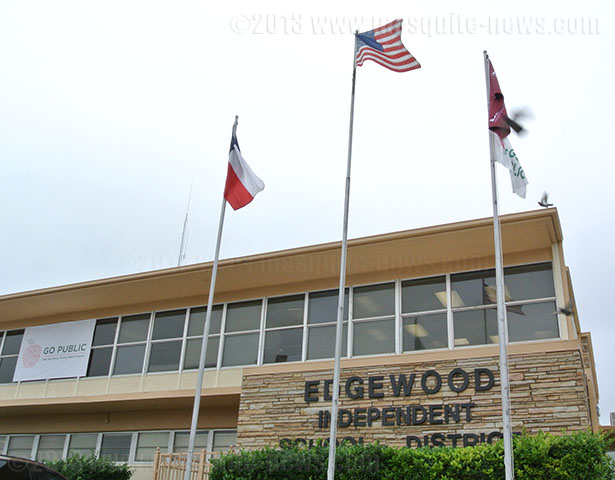
By Alma Linda Manzanares
After her siblings successfully obtained college degrees, Victoria Zamora aspired to follow the same path after high school.
“I wouldn’t call myself a bookworm but I was concerned with keeping my GPA high,” she said. Graduating at the top 10 percent of her class, Zamora was part of the National Honors Society, Spanish Honors Society, band, yearbook and even participated in a college-readiness program.
A week before her high school graduation in 2010, Zamora took the opportunity to start her higher education early, taking courses at the University of Texas at Austin as part of the Summer Scholars Program.
Now a digital filmmaking and video production sophomore at The Art Institute of San Antonio, Zamora is one student who, despite Edgewood’s historically underserved status, graduated from John F. Kennedy High School and went on to pursue college.
From 2007-2010, about 75 percent of students in the district were academically at risk, according to the Texas Tribune’s Public Schools Explorer.
Edgewood ISD has made local news recently for making improvements in attempts to transform the Westside school district, which is at the center of a decades-long legal battle over how Texas funds public education.
Despite hardship, an article in the San Antonio Express-News suggested that Edgewood may be turning around. The article featured the struggles Superintendent José Cervantes faces when launching initiatives meant to engage students and parents and develop staff.
It’s one of many education transition stories spotlighted by local media recently, including Texas Public Radio’s spotlight of “Go Public,” a campaign led by the county’s 15 independent school districts, to improve the reputation of public schools.
To show how students in underserved school districts are adjusting to higher education in Texas, The Mesquite spoke to three women graduates of Edgewood ISD pursuing higher education at three different institutions.
According to data from the district’s department of student support services, about 75 percent of graduates from the district’s 2013 class were accepted to a 4-year university.
And while the district is making statistical strides, according to those interviewed, not all students feel they were academically prepared once they reach those universities.
After being one of two participants from Edgewood ISD to participate in the summer program at UT Austin, Zamora eventually left UT Austin’s flagship university after Spring 2011 because she was dissatisfied with her grades.
She transferred to Palo Alto College, back in San Antonio, in Fall 2011 to complete her basics before transferring to the Art Institute of San Antonio in Fall 2012.
Like Zamora, Lorie Hidalgo, communications junior at Texas A&M-San Antonio, graduated in 2010 from Kennedy H.S. in the top of her class, ranked at number four.
Kennedy and Memorial High schools’ 2010 combined graduating class was one of the largest graduating classes on record, with 79 percent of students receiving a diploma, according to the Tribune’s Public Schools Explorer.
Hidalgo was enrolled in dual-credit classes and participated in the same college-readiness program as Zamora, called College Conexión, with Our Lady of the Lake University.
Established in 2008, College Conexión works with low-income, primarily first-generation Hispanic high school students in high at-risk, economically disadvantaged school districts.
Hidalgo was active in sports during her four years of high school, including basketball, volleyball, softball, track and field, and cross-country.
After her high school graduation, she took college courses in a five-week summer program at the University of Incarnate Word. Before transferring to A&M-San Antonio, she attended Northwest Vista College and earned her associate of arts in new media communications.
Hidalgo currently works in Edgewood ISD as a college tutor at Memorial. She helps an English teacher in three classes, working primarily with Spanish speaking students, and an Algebra 1 class.
“Now that I’m helping and working at the district, I can tell the kids, I was in the same situation you are and I went to Kennedy, which is just like Memorial and you don’t always get the help you need but it’s there,” she said. “If I can get out of the neighborhood, then you can also.”
A graduate of Kennedy’s 2011 class, Sasha Pinfon, community health sophomore at the University of Texas at San Antonio, also graduated in the top ten percent of her class.
Originally from Medina County, she moved to San Antonio in the third grade to be closer to Hondo, where her mother worked as a prison guard.
Like Hidalgo, Pinfon was an athlete in high school who participated in cross-country, basketball, volleyball and track. “I didn’t mind going to school,” she said. “Athletics made it better but I’ve never had a problem with going and doing the work.”
She said that it was actually her participation in sports that engaged her and made her interested in going to school. “At the same time, it helped keep me structured because you couldn’t play sports if you didn’t have the grades,” she said.
Problems in Edgewood ISD
The issue of funding for the Edgewood district has been a frequent concern. The district officially made itself known when it tackled the issue of public school funding in the landmark case, Edgewood ISD v. Kirby.
The Mexican American Legal Defense and Educational Fund (MALDEF), on behalf of Edgewood, filed suit against commissioner of education William Kirby on May 23, 1984, in Travis County, citing discrimination against students in poor school districts. The plaintiffs said the state’s methods of funding public schools violated at least four principles of the state constitution, which obligated the state legislature to provide an efficient and free public school system.
The lawsuit occurred almost a decade after the Rodríguez v. San Antonio ISD case of 1971, which asked the courts to address unfairness in public school aid. The United States Supreme Court voted against the plaintiffs in the Rodriguez case in 1973.
Plaintiffs in the Edgewood case contested the state’s reliance on local property taxes to fund public education, saying the method was unequal because property values varied greatly from district to district, creating an imbalance in funds available.
In the Edgewood case, the Texas Supreme Court unanimously ruled that the state’s public school finance system was a violation of the Texas Constitution.
Those issues which played out in the courtroom are still being worked out in the classroom.
As far as student problems in the Edgewood district, limited resources such as textbooks, student drop-outs and lack of parent involvement are some of the issues Pinfon, Zamora and Hidalgo said they experienced during their time in high school.
All three students agreed that there were not enough textbooks available for every student.
Pinfon said even though the issue did not impact her ability to learn, she noticed some students needed a textbook to “get through the class.”
Zamora said she noticed teachers tended to stray from using textbooks. “The majority of students would not bother to open a textbook unless it was in a classroom,” she said.
Hidalgo agreed. “They kind of didn’t want to let us use a textbook and our textbooks were really old,” she said. Now a mentor in the classroom, she added that the district has now updated their textbooks and recently purchased iPads for interactive learning.
Lilia Nanez, chief academic officer at Edgewood ISD, said the district has about 2,000 iPads to help students in math and science curriculums. She said every student who is enrolled in Algebra 1 has an iPad with the app FUSE, which explains Algebra 1 content through videos, illustrations, and tutorials. Nanez said the students are able to take home the iPads to complete their homework.
She said in Algebra 1, a textbook is rarely used, if not at all. “The textbooks that had been adopted 10 years ago, or maybe 8 years ago, for math are so old,” Nanez said. “They’re old, they don’t have the state standards that we are currently accountable for, so they’re obsolete. That’s why we moved to having this content online.”
Recently, Nanez said iPads have also been purchased for Algebra 2 students that are in the Toltech T-STEM (Texas-Science, Technology, Engineering and Mathematics) Academy and any student who is not in Algebra 1 but has been identified by administrators as struggling with reading instruction, has an ipad so they can participate in the reading intervention program called, Achieve3000.
Nanez said feedback on the iPads from the Student Advisory Group, whose members consist of student representatives from each school in the district, has been positive. “They love the iPads,” she said. “They wish that we did it in all classrooms, which we’re moving to that but we have to train teachers and find appropriate content.”
Student drop-outs is another concern in the district with about a rate of 5.8 between grades 9-12 from 2007-2010, according to the Tribune’s Public Schools Explorer. The state dropout rate between 2007-2010 was about 3.4.
Pinfon said in the beginning of her senior year, the school expected about more than 400 graduates. “By the end of the year, probably less than half graduated,” she said.
Although Zamora and Hidalgo’s 2010 graduating class was one of the highest in the century, there were some drop-outs.
Zamora said she thinks students drop out because school is not for them or they have personal struggles. She said the high school had a lot of teen pregnancies that could have contributed to the problem.
Zamora said although she felt like the majority of students in high school wanted to pursue higher education, there were some that felt “college wasn’t for them.” Her own perspective is that student success is based on each individual student’s attitude toward their own education.
Since working at the district, Hidalgo said she’s noticed an issue with parent involvement. She said she believes that when students start elementary school, parents are really involved, but as the years progress, “parents lose interest in what’s going on and the students stray away from what’s important.”
Monica Garcia, director of student support services at Edgewood ISD, said this year, the district hired a parent engagement coordinator to help coordinate and facilitate parent meetings. She said she has talked to parents at those meetings on how to have their students college ready. “We are really trying to focus on parent involvement,” Garcia said. “We know that’s the key.”
Standardized Tests
Edgewood ISD students have performed well below the state average in passing TAKS (Texas Assessment of Knowledge and Skills) scores.
In 2012, the district had a 56 percent passing rate for all TAKS test compared to the 75 percent state average, according to the Tribune’s Public Schools Explorer.
Pinfon, Zamora and Hidalgo agreed that during their time in the district, standardized test scores was the main focus of all teachers.
Pinfon said since the district was primarily focused on preparing for standardized tests, students were not interested in education. “Everything was just preparing for a test,” she said. “They made it seem like this is what would determine your future.”
Pinfon added that when the testing months came around, teachers seemed like they were “walking on eggshells and sweating bullets.”
She recalled teachers telling each other, “You better get your test scores up or you’re not going to be teaching next year.”
Zamora said once the testing was completed, the last couple of months of the year were not concentrated on learning anything new. “All our hard work was just for a test,” she said.
Hidalgo said since a lot of the focus was on passing standardized tests, she felt like she wasted her high school years learning material presented on TAKS. “I felt like I was robbed of something. We weren’t focusing on the things you need to know by the time you get to college.”
Struggles in higher education
Since the district’s focus was on preparing students for standardized testing, some students interviewed said that preparing students for college was not a priority.
Hidalgo said some of the things she should have been taught in high school were MLA and APA style and how to properly cite sources for research papers. “It was like a rude awakening when I started my first semester of college and they asked me to write a paper MLA style and I didn’t know what MLA was,” she said.
Pinfon said the reality of continuing to a higher education institution was not effectively communicated. “They don’t really prepare you for a college life and how the work is, the people, the structure,” she said.
She added that her high school teachers made it seem like it was “kicks and giggles” and hyped colleges and universities as being “fun.”
At the university, “you’re just another number,” Pinfon said. “Most professors don’t know you by name unless you have a small classroom set,” she said. “It’s a big shock to go from a classroom of 30 people to 300 people in a class.”
Zamora said the learning at the high school was minimal and there was not a push for students to get a higher education.
She said students were not prepared with the “proper tools” for higher education, such the importance of studying. “In high school, we didn’t have to study,” she said.
While attending UT Austin, Zamora said she noticed that the students in her class would know more about the subject than she did. In her core courses, she said she felt like she should have known a lot of the material since other students in the class knew it, but in high school, it wasn’t covered.
Garcia said since she started working for the district in July 2012, college readiness has been a primary focus. She said the district is part of GEAR UP, or Gaining Early Awareness and Readiness for Undergraduate Programs, grant that follows 8th grade students, graduates of 2018. The grant was awarded in Fall 2012.
According to the district’s website, GEAR UP is a college readiness and access program that follows this year’s 8th grade class through high school and into the first-year of college. The program aims to increase the number of students who are prepared to enter and succeed in post-secondary education.
Garcia said the program provides mentoring and tutoring services, college trips and allows for a college center at the district’s middle schools. She said the 8th grade students are working on college binders that will include their resumes. A bridge program was also purchased to keep track of the students’ online resumes and schoolwork to help them determine where they need to be for graduation, she said.
For high school students at the two district campuses, Garcia said college centers are available and staffed with the district’s counselors and advisers from programs including Advise TX, Project STAY, and Upward Bound. She said the counselors and advisers help prepare students to go to school by providing assistance with admission and financial aid applications. Communities in Schools of San Antonio is also available at both high schools.
Garcia said college trips for high school students are also coordinated by the district’s counselors who partner with student support services.
Criticism toward Edgewood ISD graduates
Coming from a district that has been known for some of the lowest standardized test scores and graduation rates in the city, has impacted students’ transition to area colleges and universities.
Pinfon and Hidalgo both recalled being criticized for graduating from Edgewood ISD.
The reputation has even taken hold within the district, which may be hard to overcome.
Pinfon said almost every year, teachers in the district would tell students, “You’re graduating from Edgewood. You’re not going to make it.”
She said she understood statistically, continuing and achieving a higher education was not in her favor. “But, it added fuel to my fire,” Pinfon said. “I didn’t want to be just another Edgewood failed statistic.”
Hidalgo said her time at the University of Incarnate Word became unwelcoming after she told a professor she graduated from Kennedy H.S. “She made a snide remark like, oh that school’s still around? How did you even make it into this program?” Hidalgo said. “I didn’t feel welcomed. I would ask for help and assistance in tutoring and they would tell me, if you don’t know the material then you’re not ready for college.”
Hidalgo said in high school, she understood Kennedy was not the best but they had smart students and teachers who wanted to help.
“It was a little insulting and my feelings were hurt by that,” she said of the criticism experienced at the university.
Hidalgo said she did not complete the summer program at Incarnate Word because of the criticism and attitude she faced.
Zamora said although she was never personally criticized for graduating from the Edgewood ISD, she has heard of other students being criticized because of its geography in the city and reputation as a low income, and low performing area.
“We expect it because we know the side of town we’re on,” she said. “We expect that Kennedy is not going to be seen as a top school. We’re just there. We’re getting by on the tests.”
Zamora said that the criticism did not bother her and instead helped motivate her.
“It doesn’t matter what type of education I got, as long as I got that diploma, then I’m on my own from there on out,” she said. “I could still succeed no matter where I attend.”






